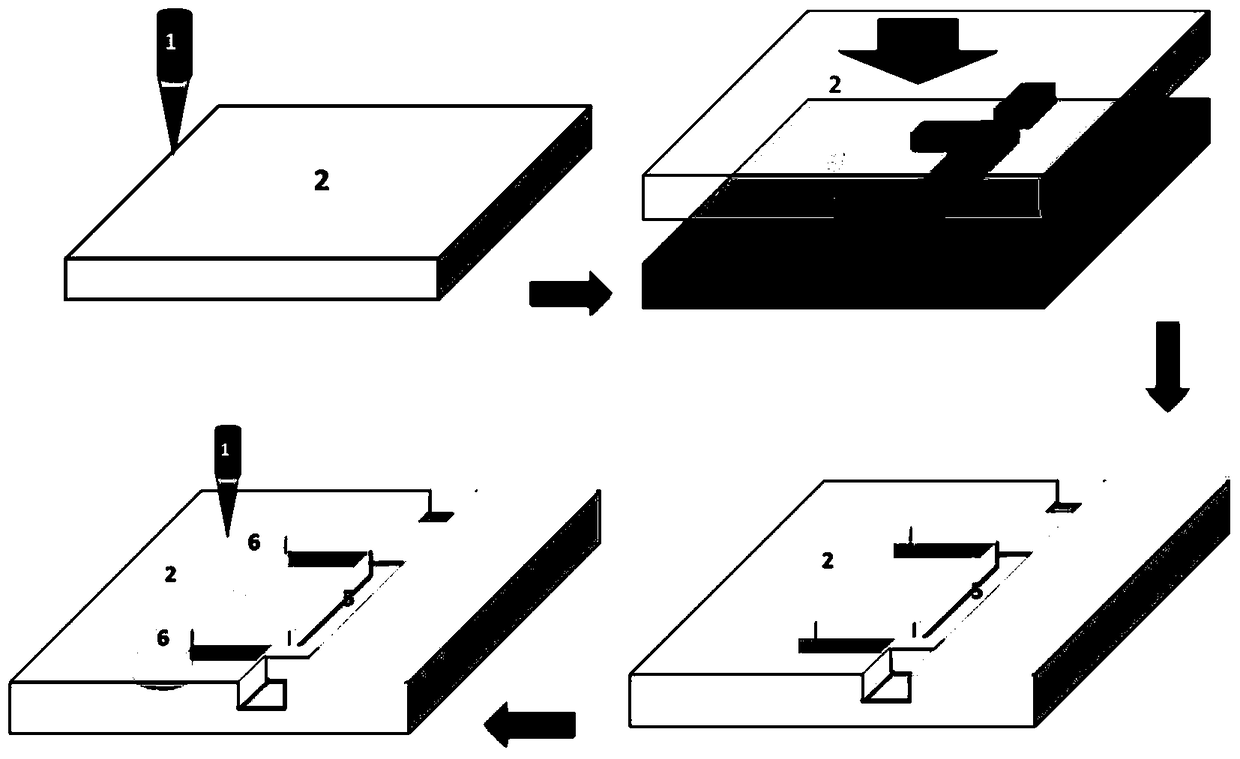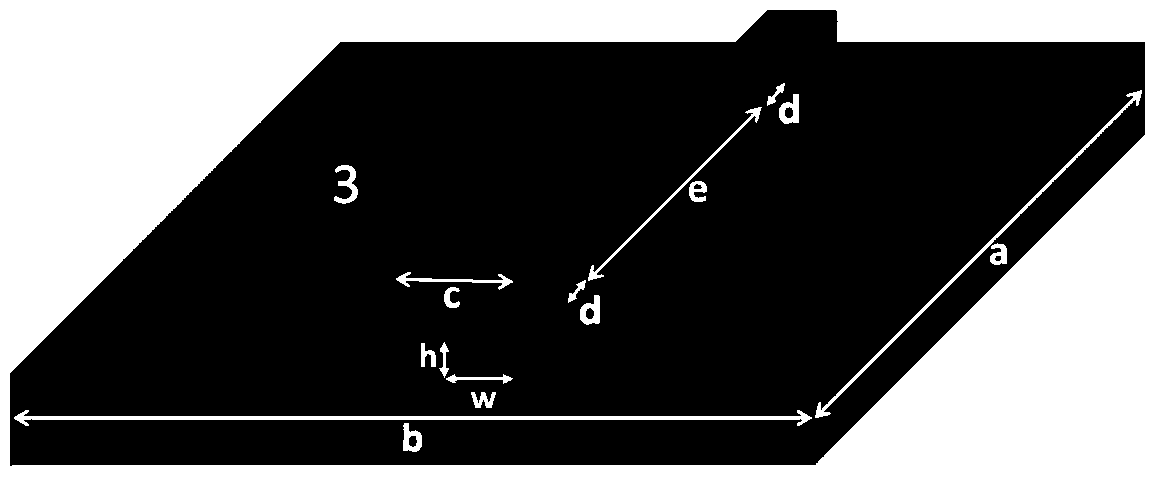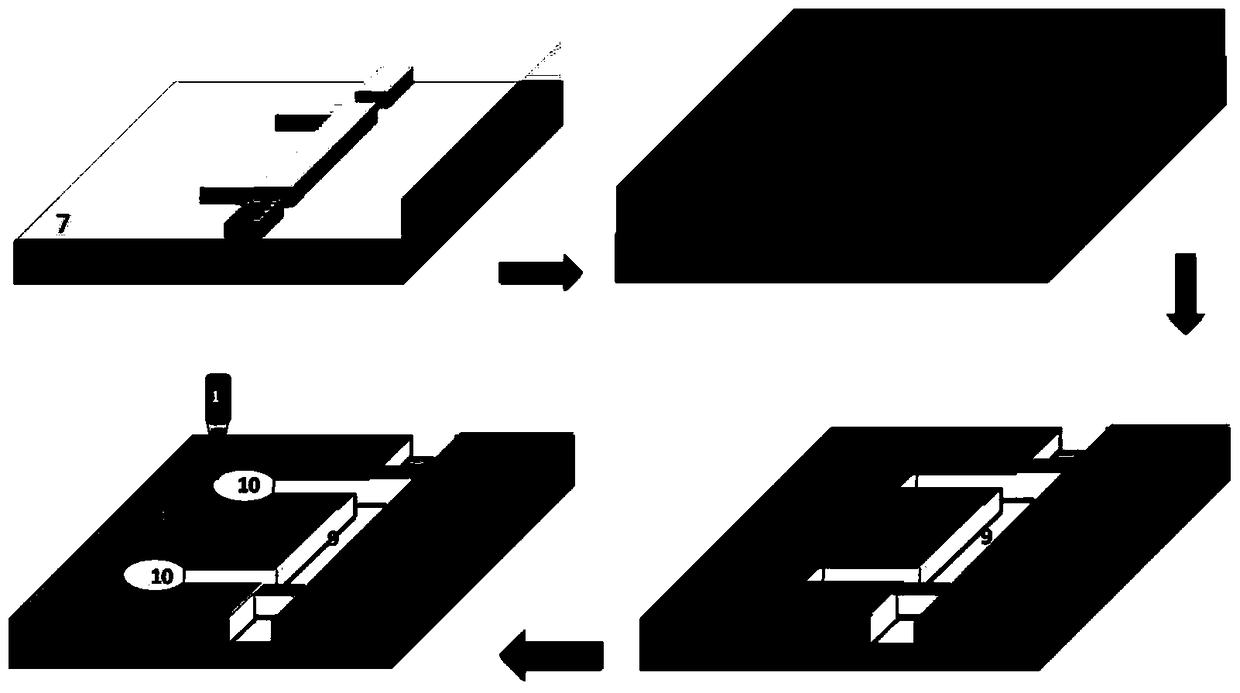A polymer photobleaching optical waveguide and microfluidic plate-free integrated chip and its preparation method
An integrated chip and microfluidic technology, applied in the direction of optical waveguide light guide, light guide, optomechanical equipment, etc., can solve the problems of increasing process cost, complicated process, and restricting the development of optical waveguide microfluidic integrated chip, so as to avoid plate alignment error, reducing the effects of bending loss and scattering loss
- Summary
- Abstract
- Description
- Claims
- Application Information
AI Technical Summary
Problems solved by technology
Method used
Image
Examples
Embodiment 1
[0034] Thermal nanoimprinting PMMA, core layer SU-8-2005
[0035] The specific process steps are as follows:
[0036] Use laser 1 to cut a surface-polished methyl methacrylate (PMMA) sheet with a thickness of 1mm (the glass transition temperature is 105°C), the cutting power is 50W, and the cutting speed is 10mm / s, and a rectangular microfluidic device is cut out. Substrate 2 (the length a is 4 cm, and the width b is 3 cm); then, a microfluidic channel groove is prepared by a thermal embossing method, and a silicon template 3 is used to emboss the groove by a thermal nanoimprint machine 4. The nanoimprint process Holding temperature 110°C, holding pressure 4kg / cm 2 , the holding time is 5 minutes, the template is naturally peeled off after imprinting, and the microfluidic channel groove 5 (line width 9 μm, depth 9 μm) is prepared. The length c of the leading and outgoing lines is 10 mm, and the length e of the middle line of the three-line structure is 20 mm. The two spacing...
Embodiment 2
[0042] Thermal nanoimprinting PMMA, core material SU-8-100
[0043] The specific process steps are as follows:
[0044] A surface-polished methyl methacrylate (PMMA) sheet with a thickness of 1mm (the glass transition temperature is 100°C) is cut with laser 1, the cutting power is 50W, and the cutting speed is 10mm / s, and a rectangular microfluidic tube is cut out. Thin sheet substrate 2 (4cm×2cm); Then prepare microfluidic channel grooves by hot embossing method, use polymer PDMS template, emboss grooves by thermal nanoimprint machine 4, the holding temperature of nanoimprint process is 120 ℃, holding pressure 1kg / cm 2 , the holding time is 10 minutes, the template is naturally peeled off after imprinting, and the microfluidic channel groove 5 (the line width is 40 μm, the depth is 40 μm) is prepared. 20mm, the two distances between the three line segments are both d is 40μm; the laser 1 is used to penetrate the ablation initial cylindrical liquid injection hole 6 at the po...
Embodiment 3
[0050] UV nanoimprint NOA63, core material SU-8-2005
[0051] The specific process steps are as follows:
[0052] First, the liquid NOA63 material 7 is spin-coated on the surface of the polydimethylsiloxane PDMS imprint template 3 (there is a protruding three-segment structure on the template), the spin-coating rotation speed is 500r / min, and the spin-coating time is 20s to form a 0.5mm thick film, and then in a UV lamp (200mW / cm 2 ) fully exposed, exposed for 300s, solidified the liquid NOA63 material 7, and formed a solid NOA63 film 8, prepared a microfluidic channel groove 9 (the line width is 9 μm, and the depth is 9 μm) on the film, and the length c of the lead-in and lead-out lines is 10 mm. The length e of the middle line segment of the line segment structure is 20mm, and the distance between the two segments of the three line segments is 9 μm; a circular liquid injection hole 10 is ablated at the port of the groove with a laser 1 (the laser power is 40W, and the cutti...
PUM
| Property | Measurement | Unit |
|---|---|---|
| thickness | aaaaa | aaaaa |
| length | aaaaa | aaaaa |
| width | aaaaa | aaaaa |
Abstract
Description
Claims
Application Information
 Login to View More
Login to View More - R&D
- Intellectual Property
- Life Sciences
- Materials
- Tech Scout
- Unparalleled Data Quality
- Higher Quality Content
- 60% Fewer Hallucinations
Browse by: Latest US Patents, China's latest patents, Technical Efficacy Thesaurus, Application Domain, Technology Topic, Popular Technical Reports.
© 2025 PatSnap. All rights reserved.Legal|Privacy policy|Modern Slavery Act Transparency Statement|Sitemap|About US| Contact US: help@patsnap.com



